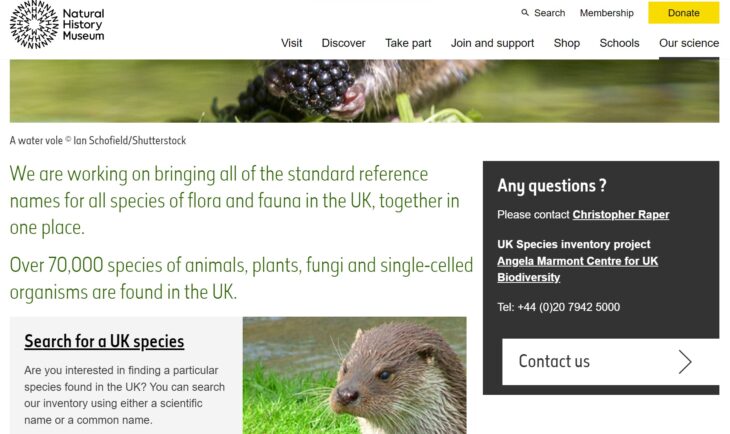Tools, resources and publications
UK Species Inventory
The UK Species Inventory plays a crucial role in enabling species data to be managed and made available electronically throughout the NBN. The Inventory has three main purposes:
- To hold standard taxonomic checklists so that records can be made against them
- To allow cross-reference between records made using different checklists, if the same species is known by different names on different lists.
- To provide a framework to help with producing reports on species.
The UK Species Inventory is managed by the Natural History Museum, although much of the actual content is created and provided by others, generally the currently accepted experts in a taxonomic area. The Inventory also holds earlier checklists for taxonomic groups, derived from, for example, published taxonomic reviews.
Structure
The structure of the Inventory is quite complicated, but for most users it is not really necessary to understand the complexities. However, there is one important point to bear in mind: that there are three separate identification tabs (known as “keys”) in the Inventory that refer to a particular name. These are (using the identifiers that are employed in the Species Inventory system):
- TAXON_KEY
- TAXON_VERSION_KEY
- TAXON_LIST_ITEM_KEY
These have an identical structure (that is, they look very similar) so it is very important when recording a species against a key that the type of key is recorded.
The UK Species Inventory website summarises the operation and performs specific functions:
• It allows users to search for names of organisms by their common and scientific names, and through a hierarchical classification. Users can also search for individual lists and their contents.
• The database serves as an archive by presenting various versions and editions of a number of important checklists, thereby allowing the user to investigate how the names, or threat statuses, of taxa within particular groups of organisms have changed through time.
• The database also holds information concerning the legal designations and conservation status of protected species.
• The underlying database draws upon information held within Recorder 2002 and many other species checklists.
• The UK Species Inventory is incorporated within a number of other NBN products. In addition to Recorder, it forms part of the NBN Gateway and the now archived NBN Index.
Translating between checklists
One of the unavoidable problems with taxonomy is that different people will know the same species by different names. This can be as a result of valid changes in the taxonomy (for example through re-classification) or simply that one worker knows a species by a different name (for example its common name as opposed to its scientific one). However, it is critical to be able to translate between the various names and particularly, when reporting, to ensure that all the available details are being used regardless of the variation of the name that a particular worker used.
To deal with this problem the Natural History Museum has developed the following approach:
- Identify the preferred taxonomy for a group – This generally involves determining what the currently accepted taxonomic source or expert for a group of organisms is and obtaining an electronic version of the taxonomic list for the group. In many cases either no expert is available or a list may be under development.
- Load available lists into the species dictionary – For those groups where the list does exist; it is loaded into the UK Species Inventory.
- Make a link to other names within that group – Some lists will include some synonymy for the preferred names they contain, but many will not. Even in those cases where synonymy does exist it may not be exhaustive and will certainly not include all of the names currently within the UK Species Inventory. These links have to be made individually by the Inventory team. This is a sizeable task, even for relatively small taxonomic groups, but only when this job is completed for a particular group can a user be sure that when they access data on a particular species all records are being included.
The Natural History Museum maintains a reporting arrangement on the current status of different taxonomic checklists, which can be referred to via the UK Species Inventory Project on its website.

